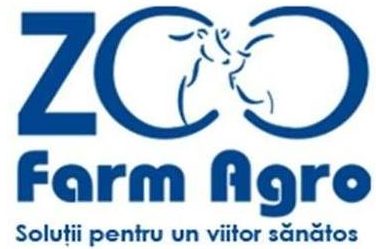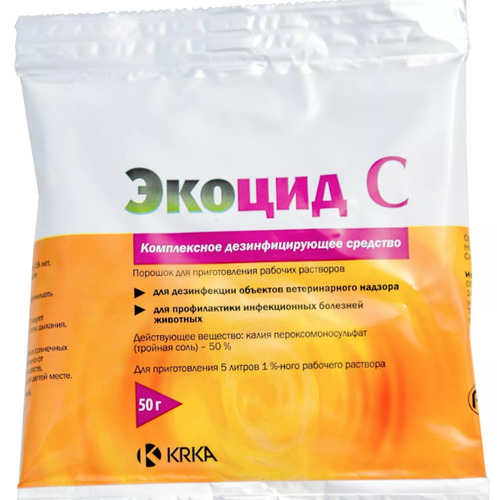Product Description
| Species | ||||||||||||||||||||||||||||||||||
|---|---|---|---|---|---|---|---|---|---|---|---|---|---|---|---|---|---|---|---|---|---|---|---|---|---|---|---|---|---|---|---|---|---|---|
| Composition | Disinfectant in the form of a granular powder of pinkish-gray color, with a faint smell of lemon; easily soluble in water.
|
|||||||||||||||||||||||||||||||||
| Indications | Preventive and forced (current and final) disinfection:
— stock-raising, pig breeding, animal husbandry, poultry facilities, including hatcheries, their technological equipment and inventory; — premises of feed workshops, fodder kitchens and other auxiliary objects of animal husbandry, technological equipment and inventory located in them; — production facilities and technological equipment at the enterprises of the meat and poultry industry, workshops for the processing of slaughter products, premises of slaughterhouses at meat processing plants and slaughterhouses, milk blocks at dairy farms and complexes, egg stores, as well as containers for storing and transporting feed and products animal origin; — automobile transport, railway wagons and other types of vehicles used to transport animals, raw materials and products of animal origin; — premises, equipment and inventory in places of animal gathering (animal trade markets, exhibitions); — veterinary institutions (hospitals, clinics, laboratories, vivariums, nurseries), their equipment, inventory, instruments and laboratory glassware; — surfaces in rooms for keeping animals, cages and equipment in kennels for breeding dogs and cats, zoos and circuses; — disinfection of water for drinking animals and water supply systems. |
|||||||||||||||||||||||||||||||||
| Dosage and method of administration | Disinfection with working solutions of Ecocide C is carried out in the absence of animals by the wet method (irrigation, wiping, immersion) or aerosol.
For prophylactic and forced (current and final) disinfection in cases of bacterial (excluding tuberculosis), viral and fungal etiology, the causative agents of which belong to 1 (low stability) and 2 (resistant) resistance to disinfectants, previously cleaned surfaces and equipment with wet or aerosol using the method, as well as in disinfection barriers and rugs, use 1% solution of Ecocide C. Forced (current and final) disinfection in African swine fever is carried out with a 3% solution of Ecocide C. Decontamination of the coat of animals that are immune to African swine fever is carried out with a 6% solution of Ecocide C. For thermal aerosol disinfection (preventive and forced) of livestock and auxiliary rooms, incubators, rooms for processing and storage of animal products and feed, slaughterhouses, 4% Ecocide C working solution is used. For disinfection of water supply systems for animals, a 0.5% working solution of Ecocide C is used. To prepare a 1% working solution, the contents of a 50 g packet are dissolved in 5 l of water. It is recommended to use warm water, where the drug dissolves faster. If you need to prepare large quantities of a disinfectant solution, you should use a package of 1 kg, the contents of which are dissolved in 100 liters of water, or a package of 2.5 kg, the contents of which are dissolved in 250 liters of water. To prepare a 0.5% working solution, the contents of 50 g of the bag are dissolved in 10 l of water. If it is necessary to prepare large quantities of a disinfecting solution, you should use a package of 1 kg, the contents of which are dissolved in 200 liters of water, or a package of 2.5 kg, the contents of which are dissolved in 500 liters of water. To prepare a 4% working solution for thermal aerosol disinfection, the aerosol stabilizer (monopropylene glycol, etc.) is first mixed with water based on 15 parts of the stabilizer per 85 parts of water, then 4 parts of Ecocide C are added to the resulting solution. To prepare working solutions for the purpose of prophylactic and forced disinfection at low temperatures (up to -18 ° С), the required amount of Ecocide C is taken and dissolved in 60% of the warm water required to prepare the solution. Then the volume of the solution was adjusted to 100% propylene glycol. Working solutions are used in accordance with the methods of application indicated in the table:
Working solutions transparent light pink. A light pink color is an indicator of the disinfectant activity of Ecocid C. If the appearance of the solution (appearance of flakes, the color of the solution turns yellow), the solution is unsuitable for use, it is necessary to prepare a fresh solution. The concentration control of Ecocid C disinfectant solutions is carried out by the express method using a test system, which is a plastic substrate about 5 × 75 mm in size, at one end of which there is an indicator zone about 5 × 5 mm in size with the applied reagent. After immersing the test system in Ecocide C solution for 3-5 seconds, a chemical reaction proceeds in the indicator zone, accompanied by a change in the color of the indicator zone in proportion to the concentration of Ecocide C in the test solution. The concentration of the solution is determined by comparing the color of the indicator zone with the color scale on the package 3-5 minutes after removing the test system from the solution. It is allowed to carry out local processing of individual animal-free machine tools in occupied livestock buildings, individual units of equipment and surface areas at enterprises, subject to ventilation of the premises and the absence of animals and people in close proximity to the objects being processed. At the end of the established exposure, surface areas accessible to animals, feeders, drinking bowls, other places of possible accumulation of disinfectant, as well as equipment from corrosion-resistant materials, are rinsed with water to remove residual disinfectant, and the room is dried. At the end of aerosol disinfection of the room, before entering the animals, ventilate for 30-60 minutes. For sanitation of drinking water for animals, including birds, add Ecocide C to water at the rate of 1000 g per 1000 l of water. The spent working solution of Ecocide C is diluted with large amounts of water and drained into the sewer. Subject to the recommendations for use, Ecocide C has no harmful effect on wastewater treatment plants. |
|||||||||||||||||||||||||||||||||
| Contraindications | To work with the drug are not allowed:
— persons under the age of 18; — pregnant and lactating women; — persons with contraindications for working with disinfectants. |
|||||||||||||||||||||||||||||||||
| Warning |
|
|||||||||||||||||||||||||||||||||
| Release form | Packed in 50 g bags of laminated foil, packed in 25 pieces. in cardboard boxes; 1 kg and 2.5 kg each – in packages of laminated foil of appropriate capacity. | |||||||||||||||||||||||||||||||||
| Storage conditions | Store the drug in the sealed packaging of the manufacturer, separately from food and feed, in a dry place, protected from direct sunlight, at a temperature of from 5 ° C to 25 ° C. | |||||||||||||||||||||||||||||||||
| Shelf life | 3 years. After opening the package, Ecocide C should be stored in hermetically sealed containers and used for a period not exceeding 28 days. Working solutions of the drug can remain active for 4-7 days. |





